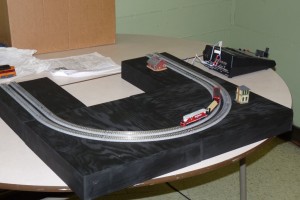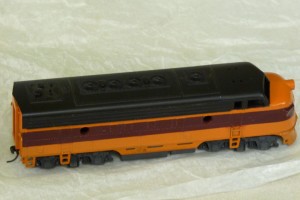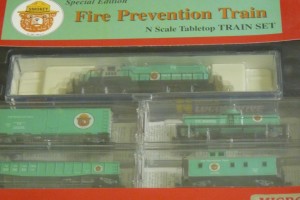Jeff Moorman / Photos by Jeff Moorman
After introductions and announcements, the May meeting started with a discussion of the tradition tour in place of the June meeting. Yes, we are going to do a tour this year and, like always, we are not going to tell folks where we are going ahead of time. There might be some last minute change, but right now the plan calls for model railroad-related destinations, a variety of scales, and maybe something more than just looking at layouts. Note that we need to know who is going ahead of time. You cannot just show up for the tour. If you have signed up, here is your official reminder:
VANS LEAVE FROM THE CHURCH PARKING LOT NO LATER THAN 7:00 PM, JUNE 2. IF YOU ARE LATE, YOU WILL MISS OUT.
Next, Bobj received his fabulous prize for being the first (and only) person to come up with documentation on the origin of the phrase, “The human mind is like a railroad boxcar, guaranteed to have a certain capacity, but often running empty.” Congratulations, Bobj; use your plastic parts box with pride.
A good part of the meeting was then devoted to the topic of “operations.” Here are some highlights: Operation is the running of a model railroad in a manner which simulates prototype activity. While there are reams and reams written about operation, they appear to be mostly concerned with designing a model railroad for operation and then implementing that design. But, it is all pretty daunting for those unfamiliar with the concepts. So, at the risk of gross oversimplification, here are some tips for trying to make sense of what’s going on, for those new to operating a model train like a prototype.
Some have called operation the ultimate board game. That is one way to look at it. But it is a board game where the players do not compete with each other; rather they cooperate to ensure smooth “operating” of the whole railroad.
Another way to look at it is that there are two basic processes: one is freight movement, and the other is train movement. Consider a semi-truck; deciding what to load it with, where to pick that stuff up, and where to deliver it, is fundamentally different from operating the truck itself, moving it safely over the road. For model railroading, freight movement is typically by carload. The entire car is filled with something going to the same place.
All sorts of “paperwork” is used to keep track of what is the car and where it is going. Some modelers even use the same forms used by the prototype railroads. Often the paperwork includes a card for each car; a train is represented by a deck of such cards. What cards go in the deck depends on what’s in the car, where it is going, how soon it needs to get there, how much the locomotive can pull, the capacity of any sidings along the way, etc. Fortunately, new operators don’t have to worry too much about the more intricate techniques of train makeup.
When it comes to running a train, there are two basic processes. One is the assembling separate cars into a train and their subsequent dis-assembly. This is often referred to as “yard work.” Moving the entire train across the railroad from one place to another is considered “road work.”
As with a semi-truck, there are rules of the road for railroads. You cannot run a locomotive/train anywhere you want to. For new operators, learning the rules of the road is usually the biggest hurdle to overcome. There are two categories of rules: one for movement of a train, basically when it is and is not allowed to proceed; and rules for real-sized people interacting with a model-sized railroad, such as are you allowed to touch rolling stock and locomotives or not. Some consider the latter type rules “owner’s rules” and they can be the most important to know.
Hopefully you now know enough about operation to be intrigued. So, if you get the opportunity, give it a try. As long as you are making a sincere effort to learn, the more experienced operators will help. Always remember:
- Know the owner’s rules
- Be considerate of others – it is all about cooperation and team effort
- Leave turnouts the way you found them
- Have fun
Once again, Show and Tell brought out some interesting stuff. Dennis had his T-TRAK modules there to show progress and hopefully inspire others to get out of their armchairs and start modeling. Chris had several paint projects in both HO and N. Stu had a nice little N sawmill with interior detail. And Rob had the latest MicroTrains fire car and an SP sky box.
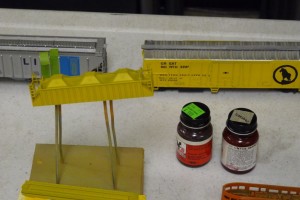
Chris' Latest Paint Project
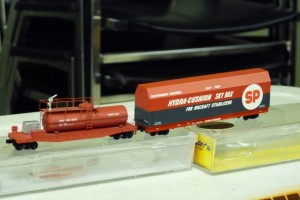
Rob's Latest from Micro Trains

Stu's Sawmill
As we were cleaning up several of us had an interesting conversation about clinic name tags. Whew! There were almost as many opinions about that as there are about what scale to model. If you want to influence my thinking on the subject, let me know your thoughts.
I still have a few T-TRAK module kits. Contact me for availability and prices. For those who have already gotten their kits or have decided to build their own, we’d like to see them at the next regular meeting in September. No, we do not want to see just the kits; we want the resultant modules, in running order.
Remember the next meeting is June 2, but only if you have signed up ahead of time. Otherwise we will see you (and your modules) the first of September.
We meet at the Ronald United Methodist Church, 17839 Aurora Avenue North, Shoreline, WA. That is on the west side of Aurora (State Route 99) just north of 175th Street, between the Cadillac dealer and Deseret Industries. Note that there is still a lot of construction along this stretch of Aurora. Therefore, it might be best to be going southbound so you can make a right-hand turn into the church driveway immediately after passing the Deseret location.
Meetings are the first Thursday of each month, except July and August. However, in June we usually do a tour. For regular meetings enter the lower level of the church from the parking lot at the rear. Doors open around 7:00 PM, announcements at 7:15, and the program starts about 7:30. Hope to see you there or at least sometime on down the line.
Remember: for June’s trip, you need to be there by 7:00 PM!





